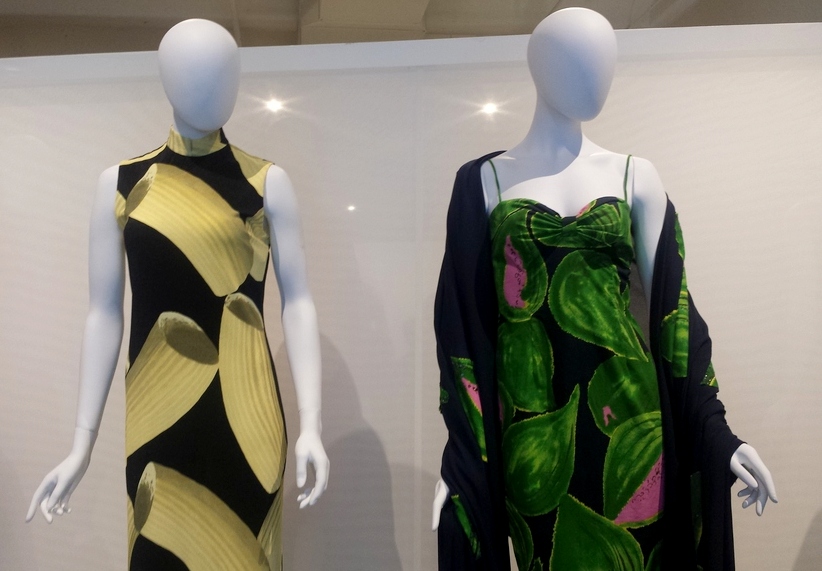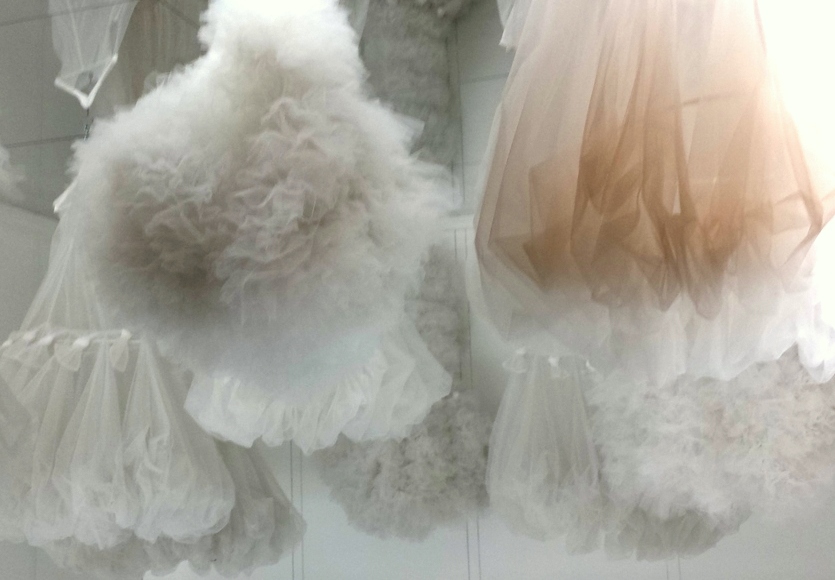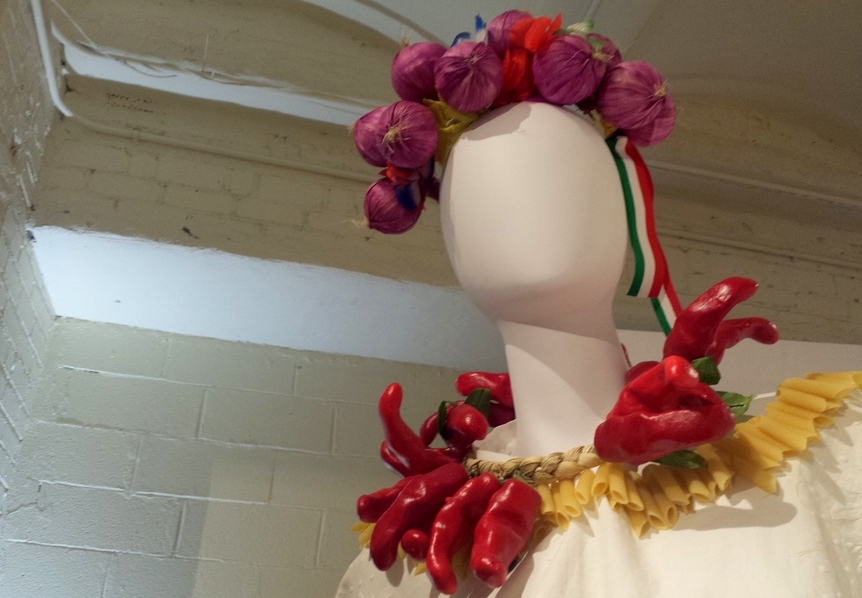LEGGI QUESTO ARTICOLO IN ITALIANO
Concurrently with the New York Summer Fancy Food show, the fashion exhibit L’eleganza del cibo, celebrating the intersection of style and taste of made in Italy, will be open until July 4th.
Food and Fashion: two worlds and two ways of living the everyday. Everyday we eat and dress not only to survive, but above all to live. And in this living, eating and dressing we inhabit the world; languages and behaviors are codified; a personal and collective identity is constructed. The way people eat and dress characterizes the images and identities of nations and their inhabitants, but also of industries, the economy and work. As a consequence, the two culture industries–food and fashion– produce not only symbolic and desirable images but also provide work for the millions of people who dedicate themselves to their development. Food and fashion are manufacturing industries that have determined industrial revolutions in the history of nations and in some cases global movements. Carlo Petrini, for example, who launched his Slow Food as a movement, lifestyle and industry that today has an enormous global following.
More than in any other nation, it is in Italy that fashion and food are the pillars of its culture, identity and aesthetic. In the Made in Italy, we immediately see the excellence of design and style and an artisanal know-how that in the 21st century is married to experimentation, technology and a concern for nature and sustainability. The nation is developing a new poetry and synergy of taste and images and a new lifestyle. If one talks about wellness in relation to food, one can also talk about wellness in relation to fashion. As food relates to territory and the landscape so fashion relates to the clothes we choose and wear in our social interactions. Food is play and creativity, performance, gesture and theatricality, so is fashion, even though the results are expressed differently.
The title of the exhibition The Elegance of Food: Tales about Food and Fashion already suggests a multiple story of synergy between aesthetics culture and language. Good food is linked to style and beauty but also to the idea of narrative and the various intersections between Italian, American and international culture,. The exhibition has been realized in collaboration with Uniindustria and curated by Stefano Dominella and Bonizza Giordani Aragno, and is sponsored by the New York office of the Italian Trade Commission (ICE). The exhibit had originally been on show at the magnificent spaces of the Museum of the Mercati Traiani in Rome, in spring 2015 during the Milan Expo. In New York, it is being held in the art space at the Chelsea Market.
“This exhibition puts together the beautiful and the good of the excellence Made in Italy,” says Maurizio Forte, director of the New York Italian Trade Commission, “this is why Italy is the envy of the whole world, our extraordinary Italian Style.”
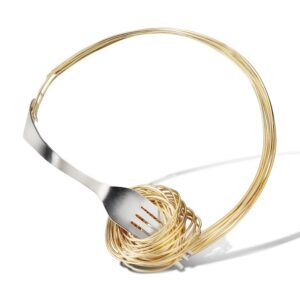 This show is important for various reasons. One of them is that it sends a clear message: fashion is a serious business, so is food. For the international development of the Made in Italy brand, this is a message that has not been completely understood. But the fact that a state office such as the Italian Trade Commission has invested in a show that explores the intersections between fashion and food in textile production and in the designs such as the elegant and original jewelry of Gianni De Benedittis, “FuturoRemoto” and shoes by Ferragamo, is a way of correcting this imbalance and to highlight the impact of fashion and design for the success of the Made in Italy.
This show is important for various reasons. One of them is that it sends a clear message: fashion is a serious business, so is food. For the international development of the Made in Italy brand, this is a message that has not been completely understood. But the fact that a state office such as the Italian Trade Commission has invested in a show that explores the intersections between fashion and food in textile production and in the designs such as the elegant and original jewelry of Gianni De Benedittis, “FuturoRemoto” and shoes by Ferragamo, is a way of correcting this imbalance and to highlight the impact of fashion and design for the success of the Made in Italy.
Fashion, with its ramifications in design, experiments in textile and colors, the manipulation of materials, the care for details, must be treated with the same attention as other cultural and manufacturing industries. All through their lives, Stefano Dominella and Bonizza Giordani Aragno have been ambassadors of the Made in Italy, working to promote Italian fashion in all its features and contexts.
Embrace the world in the company of the history, colors and emotions that come from the taste of eating and dressing Italian style: this is the experience proposed by the exhibit. These two fields, which are so important for Italian culture and the national economy, have only recently received their deserved attention from previously sedimented disciplines and fields of studies such as literature, the arts and technology. Food Studies and Fashion Studies programs are gradually being developed in departments of foreign languages and universities, not only in fashion or culinary arts schools. The role of Italy in this context is quite crucial. In the reorganization of disciplines in universities programs such as these must be taken into account, both in Italy and the US. The digital revolution has had a great transformative impact that has accelerated a process that has seen the loosening of hierarchies in the arts and other fields of knowledge. Through small windows on our computer screens, tablets or smartphones we talk to each other in a contiguity and networked format never seen before.
And yet Pellegrino Artusi, the father of Italian cuisine, defined by Prezzolini as the Dante of the Italian Cuisine, wrote the Scienza in cucina e l’arte di mangiar bene (note the intersection in the title of science and art) in Italy’s post unification years. Artusi’s book aimed at forging a linguistic and cultural norm that could act as a unifying engine for the different regional cuisines. Presenting the art and science of cooking, Italian style, in a clear manner, Artusi’s great innovation is not only the importance he gives to eating well, wellness, hygiene, but also in his claim that the taste and tactile senses could be considered as noble as those of seeing and hearing. Artusi’s book is also a precursor of the blog format. The text in fact had initially 475 recipes that later in the various reprintings of the book reached the number of 790. A great number of the additional recipes were suggested by Artusi’s readers themselves. Readers and author entered into dialogue and worked together on the new edition of the text as now happens in the blogs. Food in Italy has an important cultural and linguistic tradition. Artusi’s book can be read as a literary text and also as a story.

Fashion too in Italy has a long cultural tradition and linguistic history. The creativity and meticulous hand of Italian craftsmanship are passed down directly from the workshops that since the Middle Ages have defined the identity and economy of Italian cities and their courts. Dressing in Renaissance culture was identified as a sign of civility. Presenting oneself in society with the colors, the cut and the right fabric was the passport to success, as described by the writer and diplomat Baldassarre Castiglione, in his The Courtier, one of the first European bestsellers along with The Prince by Niccolò Machiavelli.
Food and fashion with their ancient roots are the main stays of the culture of the long duree of the Made in Italy. Initiatives such as the Eleganza del cibo exhibit narrate the story of the Made in Italy abroad and so are very welcome. This, in fact, is an exhibition that knows how to recount the beauty, richness, the know how, history, tradition, innovations, collaborations and creativity of the Made in Italy,
Many of the designers present in the shows have collaborated with cinema, theatre and television: from the youngest such as Gianni De Benedittis and Tiziano Guardini’s ethical fashion, to brands such as Gattinoni, Armani, Antonio Marras, Emilio Pucci, Max Mara, Etro, Gianfranco Ferrè, Moschino, Ken Scott, Romeo Gigli and others. Food and fashion also have synergy with other media, arts and industries and it is through these that they communicate.
Stefano Dominella, CEO of Gattinoni, a Roman based and well-established sartoria, tells me; “On the occasion of the 2015 Milan Expo, which was dedicated to nutrition, I was invited to organize an exhibition in Rome that brought together the odd couple of fashion and food. I was excited at the idea of organizing something truly creative.”
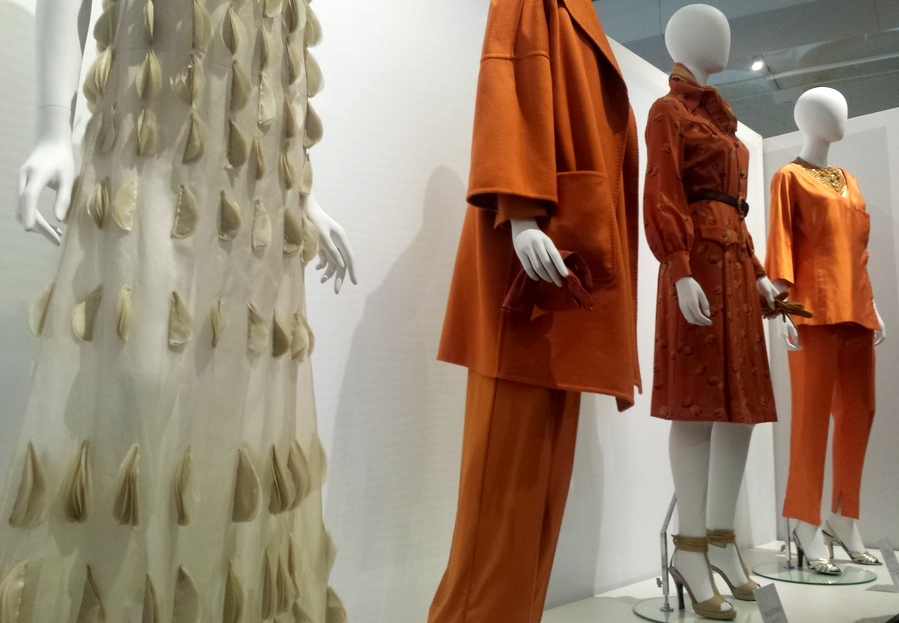
Dominella, who in the 1980s, along with Raniero Gattinoni launched the prêt-a-porter lines in the international market, has ben collaborating on various exhibitions for years with the well-known fashion historian Bonizza Giordani Aragno. They were both in NY for the opening of the show. It was nice to see Bonizza again in NY and how she is always thinking of new ways not only of exhibiting fashion but also identifying new talents of the Made in Italy. Some of them are students from the Istituto Europeo di Disegno, the Academy of Fashion and Costume in Rome. She says that: “Nowadays it is no longer possible to do a chronological exhibition, it would be really boring and it would not capture the complexity of a history that cannot be seen in a linear mode. Fashion exhibitions must be thematic and put on display a precise concept around which to mount the exhibition.”
Many Americans do not know the important history of the Gattinoni fashion house and the key role it played in the launch of the Made in Italy in the post-war years first in Florence and then in Rome, the city that would become the city of both fashion and film. Fernanda Gattinoni dressed Hollywood stars such as Ingrid Bergman, Kim Novak, Audrey Hepburn and even the American Ambassador in Rome during the cold war, Claire Boothe Luce.
Among the historical Roman ateliers, Gattinoni is the only one to survive today thanks to the work of Stefano Dominella and of the creative director Guillermo Mariotto. At the exhibit two Gattinoni designs were on display, a recent one, the “Bread suit” and “Verdura” by Raniero Gattinoni, son of Fernanda, who died a premature death in 1993.
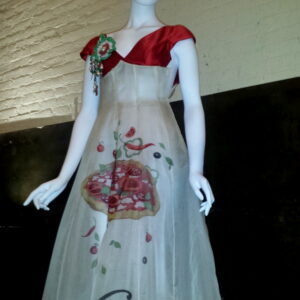 The curators, with the efficient support of the ICE team, have used the Chelsea Market spaces to the best. What better place could there be than this?
The curators, with the efficient support of the ICE team, have used the Chelsea Market spaces to the best. What better place could there be than this?
On display too are irreverent dresses by Moschino, his “Pizza napoletana”; the “Cristalli” dress by Romeo Gigli, genial with its sculptural impact and the lightness of its small pleats; the wonderful dress by Armani, “Bamboo”; “Limoni” by Walter Albini; the kimono “Tagliatelle” by Maurizio Galante; the American Ken Scott, who established himself in Italy and dedicated many of his textile prints to food; or the young Italo Marseglia with 10 cloud dresses made out of 500 meters of tulle: these dresses are suspended from the ceiling in a circular space and look like clouds. These are dresses that are not only extrovert and witty, but also elegant and eminently wearable. Some of the dresses investigate the limits of the concept of dress, of the body and space.
 At the entrance in the show there are two outfits by the eco designer Tiziano Guardini who, also present at the opening of the show, explained that he created three dresses from his FW 2016-2017 collection:. a couture dress made of tree bark; an ensemble of a silk shirt; and a skirt made of jute and pine needles. These dresses too resemble sculptures but also have an exquisite elegance. Guardini explains to me that the silk of the shirt “Aimsha” or “Gandhy Silk” comes from the Himalayas and was obtained only after that the larva have completed their metamorphosis “producing a thread with an irregular effect.” I touched the diaphanous lightness of this silk. It was like touching the wings of a butterfly: the collection, in fact, is called “Three Days to Butterfly.” I can only imagine what a delicate sensation it must be to feel this silk on one’s skin. It is with this image of lightness and respect for nature that I would like to conclude.
At the entrance in the show there are two outfits by the eco designer Tiziano Guardini who, also present at the opening of the show, explained that he created three dresses from his FW 2016-2017 collection:. a couture dress made of tree bark; an ensemble of a silk shirt; and a skirt made of jute and pine needles. These dresses too resemble sculptures but also have an exquisite elegance. Guardini explains to me that the silk of the shirt “Aimsha” or “Gandhy Silk” comes from the Himalayas and was obtained only after that the larva have completed their metamorphosis “producing a thread with an irregular effect.” I touched the diaphanous lightness of this silk. It was like touching the wings of a butterfly: the collection, in fact, is called “Three Days to Butterfly.” I can only imagine what a delicate sensation it must be to feel this silk on one’s skin. It is with this image of lightness and respect for nature that I would like to conclude.
In the next posts I will continue to dedicate my attention to the work of new designers of the Made in Italy present in the show L’eleganza del cibo and of its tales and paths of fashion and design.




